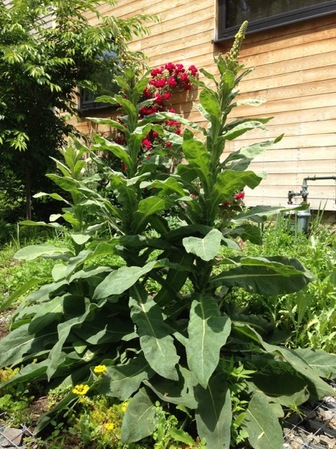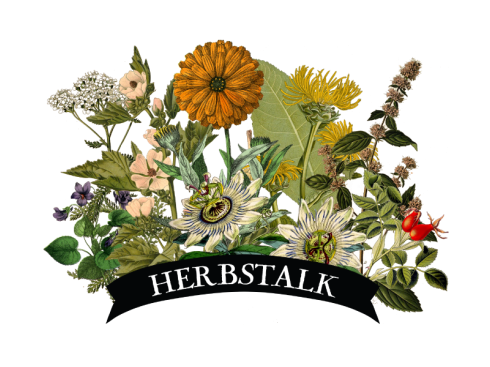|
by Patrice Green  On a recent long drive, I noticed a profusion of Mullein in full bloom along the highway. Once you've identified it, there's no mistaking this beautiful plant. Mullein, Verbascum thapsus, is a biennial. A first year plant is easily recognized by its beautiful, soft, grayish-green leaves which grow in a basal rosette. The leaves can grow in excess of twelve inches, and have a soft down covering. During its second year, the tall, flowering stalk grows and the distinctive five-petaled yellow flowers bloom. When dry, the down on both the leaves and the stalk ignite easily, which is how the plant got its nickname, "Candlewick Plant." In fact, the Romans used Mullein stalks as candles and called the plant, ‘candelaria.’ When researching the plant for this article, I was surprised to learn that a single mullein can produce up to 100,000 seeds in a year. The seeds can also last up to one hundred years, waiting for optimal growing conditions before sprouting. This could be one reason Mullein is often among the first plants to grow in disturbed soil. Perhaps the best known medicinal use of mullein is an olive oil infusion of mullein flowers for ear infections and ear aches. Often garlic is added to the infusion. The oil is slightly warmed then a few drops are added to the affected area. Mullein is both anti-inflammatory and analgesic, and also has antiseptic properties. It is both demulcent and astringent, which makes it an ideal remedy for lung ailments, as it soothes while drying up excess mucous. The large leaves of the mullein are an indicator of its affinity for the respiratory system. Mullein teas and tinctures are often used to treat asthma, coughs and bronchitis. Mullein also has slightly sedative and narcotic properties, making it a useful remedy for coughs that can disturb sleep. Many people use the smoke from mullein leaves for acute respiratory ailments, as mullein has expectorant properties and also reduces pain and inflammation. In this manner, dried mullein can be burned as a smudge or incense and inhaled to quell stubborn coughing. Mullein root is helpful for incontinence, as it tightens and strengthens the urinary system. A piece of mullein leaf wrapped around a sprain and held in place with gauze will align tissue, ligaments and tendons and reduce swelling. I like to harvest the leaves, wrap them in a paper towel, put them in a Ziploc baggie and store them in the freezer so I always have a supply on hand. I’ve used it to speed up healing a sprained ankle. Also, I recently injured my finger and am using mullein in this way with good results. A word of caution, though: some people experience contact dermatitis from the down on the leaves. You may also run the risk of having close friends and family refer to you as “salad foot” or some such moniker. There are so many wonderful plant allies that it’s hard to play favorites, but mullein certainly is one of the herbs I always try to have on hand. As one of my teachers, Isa, is fond of saying, “All hail, Mullein!” Resources: http://www2.fcps.edu/islandcreekes/ecology/common_mullein.htm http://www.botanical.com/botanical/mgmh/m/mulgre63.html  Patrice Green is an Herbal Educator, Certified Aromatherapist, Energy Medicine and Reiki Practitioner and founder of Green Aromatics. She is also the Assistant Director at the Boston School of Herbal Studies. She received her herbal training at the Boston School of Herbal Studies, and shamanic training from Isa Gucciardi, Ph. D. at the Sacred Stream in Berkley, CA. Inspired by time spent among the coastal Redwoods of Muir Woods and its beach, Green Aromatics strives to imbue its products and services with the same resilience, joy and equanimity of these majestic beings. Patrice may be reached through the Green Aromatics website. Comments are closed.
|
Archives
November 2023
Categories
All
|
Join the Newsletter!
Receive news about future Herbstalk events
Thank you!
You have successfully joined our subscriber list.
Copyright © Herbstalk 2024

 RSS Feed
RSS Feed